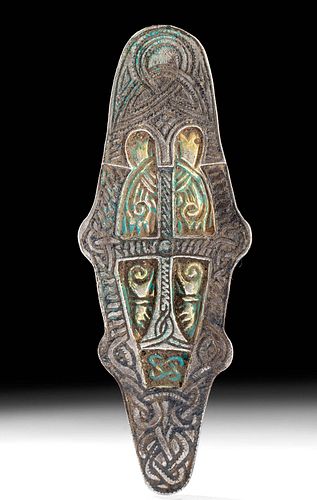Viking Gilt Silver Buckle w/ Cross & Triquetra - 22.3 g
Lot 64c
About Seller
Artemis Gallery
686 S Taylor Ave, Ste 106
Louisville, CO 80027
United States
Selling antiquities, ancient and ethnographic art online since 1993, Artemis Gallery specializes in Classical Antiquities (Egyptian, Greek, Roman, Near Eastern), Asian, Pre-Columbian, African / Tribal / Oceanographic art. Our extensive inventory includes pottery, stone, metal, wood, glass and textil...Read more
Categories
Estimate:
$2,000 - $3,000
Absentee vs Live bid
Two ways to bid:
- Leave a max absentee bid and the platform will bid on your behalf up to your maximum bid during the live auction.
- Bid live during the auction and your bids will be submitted real-time to the auctioneer.
Bid Increments
| Price | Bid Increment |
|---|---|
| $0 | $25 |
| $300 | $50 |
| $1,000 | $100 |
| $2,000 | $250 |
| $5,000 | $500 |
| $10,000 | $1,000 |
| $20,000 | $2,500 |
| $50,000 | $5,000 |
| $100,000 | $10,000 |
| $200,000 | $20,000 |
About Auction
By Artemis Gallery
Feb 13, 2020
Set Reminder
2020-02-13 10:00:00
2020-02-13 10:00:00
America/New_York
Bidsquare
Bidsquare : Exceptional Antiquities, Asian, Ethnographic
https://www.bidsquare.com/auctions/artemis-gallery/exceptional-antiquities-asian-ethnographic-4848
An important one-day auction featuring museum-worthy examples of Egyptian, Greek, Roman, Etruscan, Near Eastern, Far East / Asian, Pre-Columbian, African / Tribal, Oceanic, Native American, Spanish Colonial, Russian, Fossils, Ancient Jewelry, Fine Art, so much more! Artemis Gallery info@artemisgallery.com
An important one-day auction featuring museum-worthy examples of Egyptian, Greek, Roman, Etruscan, Near Eastern, Far East / Asian, Pre-Columbian, African / Tribal, Oceanic, Native American, Spanish Colonial, Russian, Fossils, Ancient Jewelry, Fine Art, so much more! Artemis Gallery info@artemisgallery.com
- Lot Description
Northern Europe, probably Gotland or Denmark, Viking period, ca. 10th to 12th century CE. A beautifully preserved gilt silver buckle or strap end, a masterwork of the Viking style that also features Christian elements. The elongated ovoid form centers on a relief cross surmounted by a large triquetra and surrounded by further intertwined motifs. Set back from the cross and gilded is a zoomorphic form including the classic Viking motif of grasping paws on its lower end. This remarkable example combines Christian, Viking, and Celtic elements. Low horizontal tabs on the back indicate that it was once attached to a strap or another metal component. Size: 3.25" W x 1.2" H (8.3 cm x 3 cm); the silver is 84% pure while the gilt is 61% gold (equivalent to 14K+); total weight: 22.3 grams
The use of the triquetra in Viking art is fascinating - scholars are not sure if it was used to represent the Christian Trinity or concepts in Norse mythology. It originated in the Celtic world and first appears in Viking art from the mid-9th century, when it was associated with women's brooches. Then Cnut the Great (r. 1016-1035), king of Denmark, Norway, and England, added it to his coins, as did king Harald Hardrade (r. 1047-1066). The presence of the cross indicates that, for whomever owned this lovely item, it was symbolic of the Trinity. That person may have been from Roskilde, Denmark, whose cathedral, founded with Anglo-Saxon connections around 1000, was dedicated to the Trinity.
See a very similar example at the British Museum (1921,1101.189).
Provenance: private New York, New York, USA collection; ex-private Kaliningrad (Koenigsberg) and then Latvia collection, acquired prior to 1982
All items legal to buy/sell under U.S. Statute covering cultural patrimony Code 2600, CHAPTER 14, and are guaranteed to be as described or your money back.
A Certificate of Authenticity will accompany all winning bids.
We ship worldwide and handle all shipping in-house for your convenience.
#151363Rich patina on all surfaces. Some light scratching and deposits but details and form are very clear. This would have once been attached to something else (see tabs on back) that is now lost.Condition
- Shipping Info
-
All shipping is handled in-house for your convenience. Your invoice from Artemis Gallery will include shipping calculation instructions. If in doubt, please inquire BEFORE bidding for estimated shipping costs for individual items.
-
- Buyer's Premium



 EUR
EUR CAD
CAD AUD
AUD GBP
GBP MXN
MXN HKD
HKD CNY
CNY MYR
MYR SEK
SEK SGD
SGD CHF
CHF THB
THB














